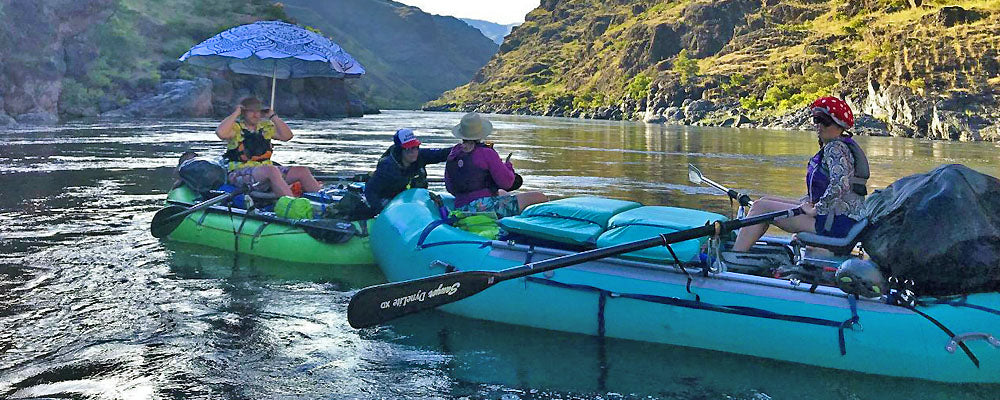Hell’s Canyon, the deepest canyon in North America, is located on the border between Idaho and Oregon. The canyon gets its name from a Lewiston, ID newspaper story and is likely named Hell’s Canyon because its deepest point cuts through “The Seven Devils” mountain range.
Deep within Hell’s Canyon lies a formidable section of the mighty Snake River. The Snake drains northern Wyoming and the lion's share of the water within the state of Idaho. By the time it reaches the reservoirs above Hell’s Canyon Dam, it has been flowing for several hundred miles and is a throttled beast waiting to be unleashed by the dam.

Statistically speaking, it’s the easiest of the four permitted Idaho sections to win, thanks to dam control making for a very long season. The permit itself doesn’t carry a high cost like the other river permits do, and many Idaho residents run Hell's Canyon several times a year.
If you are coming from far away, like Colorado or Utah, there are some things to know ahead of time when it comes to planning your Hell’s Canyon Trip:
There are Two Take-Out Options
When applying for your permit, you’ll notice that you need to input your desired take out-location; Pittsburg Landing, ID, or Heller Bar, WA. These are two distinctly different sections and it's important to understand each choice before applying.
Hell’s Canyon Dam to Pittsburg Landing
Short, rocky section that has most of the named rapids in Hell’s Canyon. Most campsites aren’t great, but the whitewater moves you through this section quickly. Most trips reach Pittsburg Landing in 2-3 days.
Pittsburg Landing to Heller Bar
Longer section where the river is generally calmer. Due to high flows constricted by the canyon, the water still moves you along at like 5-8 miles per hour for the first few days and you can still make good mileage. The river transforms when it reaches the confluence of the Salmon River, where rocky shoreline becomes sandy beaches. This section is also known as the “Snake Lake”, as the gradient of the river flattens and the river slows down. Depending on the time of year and the flow of the salmon, this section can vary in terms of how long it takes to float out. Most people do Hell’s Canyon Dam to Heller Bar in about 6-7 total days

Craft Limit
One thing that will jump out to a seasoned TL when reviewing the regulations for Hell’s Canyon is that the total number of craft you are allowed to launch with is limited to eight crafts.
What?! You can have 24 people but only 8 rafts?
Kayaks, SUPS, and Duckies also count towards that craft limit.
But Why? Well, when you arrive, you get it. Hell’s Canyon dam is jammed into the bottom of Hell’s Canyon in pretty much the middle of nowhere. The boat ramps are down a one-way traffic road and there are both commercial and private trips all waiting to launch.
In short, if they allowed a whole gaggle of crafts on each trip, multiple parties would quickly run into issues at the launch when it comes to room to rig and tie up. If you can rig on your trailer before launching, that’s ideal.
Editor's Note: They just redid their boat launch in September and I believe there is an increased capacity of launches for 2021. I am unsure of the status of this project currently.

The regulations do not specify the total number of crafts on the water, just the total number of crafts at the launch site. While the regulations are murky in this regard, we’ve found that kayakers, ducky-ers, and stand up paddleboarders can bring their craft rolled/rigged on a raft at launch, then deployed once the group has left the put-in.

A Word About Jet Boats:
There are two sections of “Hell’s Canyon." You’ll see a few jet boats above Pittsburg Landing, mostly outfitters / mail boats, and otherwise you pretty much have the canyon to yourself.
Below Pittsburg landing, you start to encounter jet boats more frequently, like WAY more frequently. They are extremely common and are something you just have to get used to if you want to float all the way out to Heller Bar, WA.
Some of the folks in that community can be a bit resentful of rafters and small crafters on the Snake for some reason, and it's best to stay out of their way. Generally, they will wait for you if you are running a rapid before proceeding up or downriver, but keep your head on a swivel and try to give them the space they need to get past your trip.
Jet boats are often going to run different lines than you would in a raft, so it’s best to give them as much space as possible and adopt a “when in doubt, eddy out” mentality around them.


